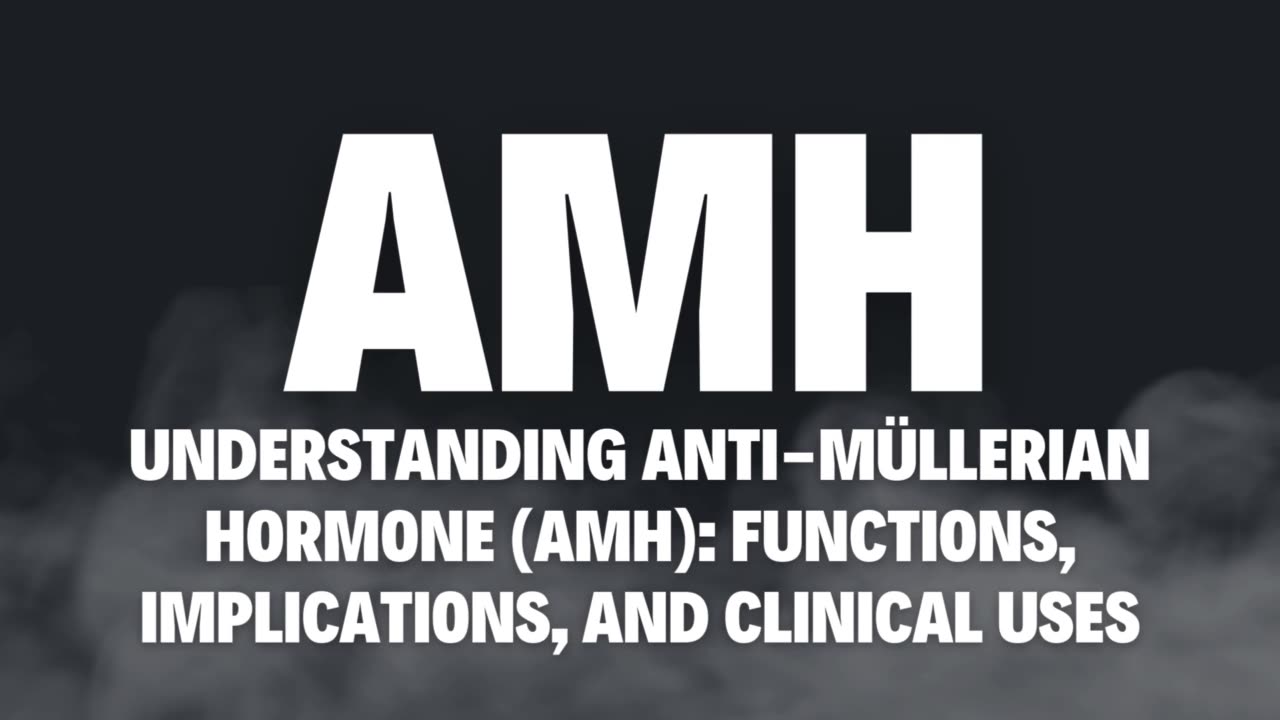Premium Only Content

Everything You Need to Know About Anti-Müllerian Hormone (AMH): Role, Function, and Clinical Uses
Understanding Anti-Müllerian Hormone (AMH): Functions, Implications, and Clinical Uses
Anti-Müllerian Hormone (AMH), also known as Müllerian-inhibiting substance, is a protein hormone that plays a crucial role in the development and function of the reproductive system. Originally identified for its role in male fetal development, AMH has gained significant attention in recent years for its implications in female fertility and its utility in clinical diagnostics.
The Role of AMH in Male Development
AMH is secreted by the Sertoli cells of the testes in male fetuses. Its primary function during embryonic development is to inhibit the development of the Müllerian ducts, which would otherwise differentiate into female reproductive structures such as the uterus, fallopian tubes, and the upper part of the vagina. By promoting the regression of these ducts, AMH ensures the proper development of the male reproductive tract. The hormone continues to be produced at high levels during infancy and childhood but declines significantly after puberty.
AMH in Female Reproductive Health
In females, AMH is produced by the granulosa cells of ovarian follicles. Unlike in males, AMH does not have a developmental role in the regression of Müllerian ducts. Instead, it serves as a marker of ovarian reserve, which refers to the number and quality of remaining eggs in the ovaries. AMH levels are relatively stable throughout the menstrual cycle, making it a reliable indicator for assessing ovarian function.
Clinical Applications of AMH
Fertility Assessment:
AMH levels are commonly measured in women undergoing fertility evaluations. Low AMH levels may indicate diminished ovarian reserve, which can affect a woman's ability to conceive. Conversely, high levels of AMH can be associated with conditions like polycystic ovary syndrome (PCOS), which is characterized by an overabundance of ovarian follicles.
Predicting Menopause:
Since AMH levels decline with age and drop to undetectable levels at menopause, they can be used to estimate the onset of menopause. This information can be valuable for women making decisions about family planning and managing perimenopausal symptoms.
Monitoring Ovarian Function in Cancer Patients:
Women undergoing treatments for cancer, such as chemotherapy or radiation, can experience a decline in ovarian function. AMH testing can help monitor the impact of these treatments on the ovaries and guide decisions regarding fertility preservation.
Polycystic Ovary Syndrome (PCOS):
Elevated AMH levels are often found in women with PCOS. AMH can be used as a diagnostic marker for this condition, aiding in the identification and management of PCOS, which can affect menstrual regularity and fertility.
Assisted Reproductive Technology (ART):
In the context of in vitro fertilization (IVF) and other ART procedures, AMH levels help predict ovarian response to stimulation. This can assist clinicians in customizing treatment protocols to optimize the chances of successful egg retrieval and embryo implantation.
Factors Influencing AMH Levels
While AMH is a valuable marker, it is influenced by various factors. Age is the most significant determinant, with levels peaking in early adulthood and gradually declining as a woman approaches menopause. Other factors, such as genetic predispositions, lifestyle choices, and underlying health conditions, can also affect AMH levels.
Conclusion
Anti-Müllerian Hormone (AMH) is a versatile and informative hormone with critical roles in both male and female reproductive health. From its essential function in male fetal development to its application in assessing female fertility and managing reproductive disorders, AMH has become an indispensable tool in modern medicine. As research continues to uncover more about this hormone, its clinical applications are likely to expand, offering even greater insights into reproductive health and disease management.
-
 LIVE
LIVE
The Official Steve Harvey
12 days ago $4.73 earned24 HOURS OF MOTIVATION w/ STEVE HARVEY
4,635 watching -
 21:24
21:24
marcushouse
7 hours agoStarship Flight 10: Go or No? 🚀
192 -
 5:40
5:40
WhaddoYouMeme
3 days ago $0.10 earnedThey’re Calling This the End of Masculinity
4282 -
 15:24
15:24
Tactical Advisor
15 hours agoBest 2011 of 2025 | Bul Armory Ultralight Pro
829 -
 27:31
27:31
True Crime | Unsolved Cases | Mysterious Stories
1 day agoThe Hong Kong Schoolgirl Mystery – 5 Mysterious Unsolved Cases (Part 8)
171 -
 7:19
7:19
China Uncensored
22 hours agoChina is DONE in the South China Sea
2.35K11 -
 LIVE
LIVE
Joe Donuts Live
2 hours ago🟢 Loot Rats Unleashed: Arena Breakout Chaos! | Joe + Tony + Vlad
589 watching -
 30:37
30:37
Degenerate Plays
14 hours agoThis College Is Out Of Control - GTA Online : Part 9
40 -
 16:28
16:28
Mrgunsngear
2 days ago $0.49 earnedBeretta 92XI SAO Sabbia Review - A Few Surprises
3.46K5 -
 1:48
1:48
Memology 101
1 day agoThis aged like milk for Tish James...
6845